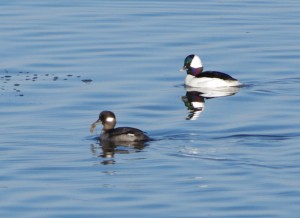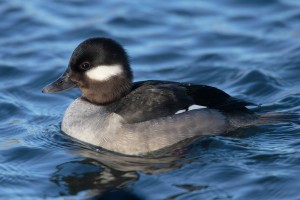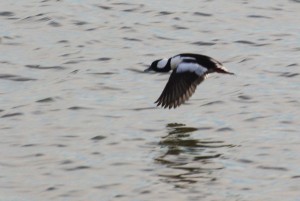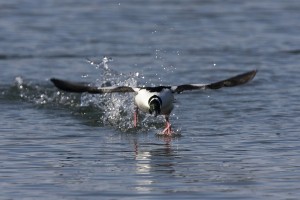Order: Anseriformes
Family: Anatidae
Genus: Bucephala
Species: Bucephala albeola

Male Bufflehead starting a dive. By marlin harms [CC-BY-2.0 (http://creativecommons.org/licenses/by/2.0)], via Wikimedia Commons
Introduction:
The Bufflehead distinguishes itself among waterfowl. Characterized by exuberance and a minute figure of 12-16oz (Todd 1979), it remains one of the smallest diving ducks of North America, (Johnsgard 1979). The most endearing nickname commonly used is butterball, (Todd 1979). The nickname was bestowed with regard to its chubby figure during fall migration, (Boreal SongBird Initiative). This cavity-nesting boreal breeder (Gauthier 1993) is no sloth; it is energetic, lively and at times quite aggressive.
The Bufflehead has a noticeably disproportionate head in comparison to its compact body. Head size is often exaggerated by the flaring of head feathers similar to that of the Hooded Merganser, (Johnsgard 1955). The large head is accompanied by a short neck and a slim, slate gray bill. Its pink legs and feet are positioned towards the tail to aid in swimming and diving, (Sibley 2003). It has anisodactyl toes and palmate feet with the exception of a lobed hallux. The lobed hind digit is a unique characteristic among diving ducks, (Erskine 1961). This adaptation aids the Bufflehead’s aquatic locomotion, (Schummer et al. 2008).

Copyright cyric, licensed under a Attribution-NonCommercial-ShareAlike License license: http://creativecommons.org/licenses/by-nc-sa/3.0/
The female’s plumage is drab in comparison to males. Mostly dominated by dark browns and grays, the females are distinguished by an oval patch of white on the auriculars. The males have an abundance of white, contrasted with black and iridescence. The head is also the most diagnostic feature of the males. Its head is a near-black iridescence composed of purples, greens, and blues. From the auriculars, a white patch extends around the nape and occiput, but does not reach the crest. Both sexes have white patches on their secondaries. The male’s patch, however, is more extensive and extends onto the secondary coverts.
.

© NatureServe
Supplier: Birds of DC, National Museum of Natural History, Smithsonian Institution
Source: NatureServe
Editor: Birds of DC
Ridgely, R. S., T. F. Allnutt, T. Brooks, D. K. McNicol, D. W. Mehlman, B. E. Young, and J. R. Zook. 2007. Digital Distribution Maps of the Birds of the Western Hemisphere, version 3.0. NatureServe, Arlington, Virginia, USA.
The Bufflehead’s range is restricted to that of North America. Excluding primarily the northern extremes of Canada and Alaska, Buffleheads can be found just about anywhere in the United States in right season, (Sibley 2001). In summer, breeding population are predominantly restricted to the interior boreal forests of Canada and Alaska, (Gauthier 1993). During the breeding season, Buffleheads reside on mainly freshwater habitats, (Soothill and Whitehead 1996). In winter, population density is concentrated on the Pacific and Atlantic coast, decreasing further inland, (Bird Web, Seattle Aububon Society). There are some documented occurrences of accidental migrators reaching as far as Japan and Britain, (Erskine 1961).These occurrences are by chance however, and are not established migrational habits.
.
Because Buffleheads are specialized diving birds, they are found in a wide spectrum of aquatic habitats. It is not uncommon for them to be found residing on ponds, lakes, rivers, bays, and harbors, (Sibley 2001). A major niche requirement, in conjunction with water, is a nesting site. As a cavity-nesting duck, riparian forests are essential. Bufflehead distribution is contingent upon these two niche requirements, (Gauthier and James 1987).

Supplier: Flickr: EOL Images
Photographer: Minette Layne
Location Created: Seattle, Washington, United States
Buffleheads are dependent upon Flickers. They rely on excavated woodpecker holes for nesting. Buffleheads prefer cavities made by Colaptes auratus, (Northern Flicker), due to its perfect size compatibility and are capable of nesting in cavities that are a mere 2.24 inches in diameter, (Boreal Songbird Initiative). It is believed that Buffleheads co-evolved with flickers to fit this specific niche, (Gauthier 1993)(Erskine 1961). This perfect fit manages to exclude sympatric ducks that are too large to fit, eliminating interspecific nesting competition. Nesting in larger piciformes holes, such a Dryocopus pileatus, (Pileated Woodpecker), runs the risk of interspecific nest site competition and potential lethal encounters with other cavity nesting ducks. Decreased nesting sites increase competition and can cause the need for aggression among individuals to maintain territory, (Usai 1999). The Bufflehead, as well as other Bucephala members, are known for their aggressiveness. This aggressive territoriality decreases potential nest sites for Buffleheads and successfully limits potential breeding density, (Gauthier 1993). Competition pushes many Buffleheads to use already occupied cavities. There are debates whether this is brood-parasitism, or simple nest site competition, (Ahlund, M. 2005). In summary, the Buffleheads nesting niche is comprised of two main components: Flicker cavities in relation to distance from water.
.
Buffleheads exclusively satisfy their nutritional needs through diving, (Gauthier 1993). Spend any decent amount of time observing this species and you will find that they spend the majority of their time foraging for food. They gracefully slip under the surface of the water in one fluid loping dive. Head first and tail last, they leave only a small ripple and a few drops of water temporarily suspended in air. Taking advantage of their evolutionary ability to dive, they scan the bottom of aquatic environments for viable food options. The Buffleheads’ diet consist of mostly aquatic invertebrates, (Gauthier 1993). Insects, crustaceans, and mollusks are its prime picks, although this can vary with the addition of seeds, fish, and aquatic vegetation, (Schummer et al. 2008). Diet is dependent on the environment and will vary according to resource availability, therefore fresh water habitats yield different foods than marine habitats. Fresh water habitats yield primarily insects and mollusks; marine habitats yield crustaceans and mollusks, (Soothill and Whitehead 1996).
A study done on energy based carrying capacities showed an increase in energy use with wind speed, pointing towards decreased carrying capacity in open waters (McKinney et al 2012). Carrying capacity was larger than bufflehead populations at each site monitored, which could be due to ” an number of behavoiral processes” (McKinney et all 2012). The study also showed a greater difference between carrying capacity and density in urban and rural locations. Rural sites had a density/ carrying capacity while urban sites showed no correlation. (McKinney et all 2012). According to their citations of (Campbell 1978), (Hall et al 1997), and (Blair 1996), it was suggested that increased pedestrian and auto movement, noise, pets, contaminants, and introduced species could be effecting bufflehead populations in urban areas.
In a study documenting foraging behavior of buffleheads comparing harvested (100 meter disturbed buffers) and unharvested (with a buffer greater than 450 meters) woodlands in Canada, it was found that there was no difference in dive duration, correlating with the harvest factors. There was a negative correlation with dive duration and clarity (Pierre et al 2005).
.
Fight:
Unlike the Common and Barrow’s Golden eye, Buffleheads have no audible wind beats. (Soothill and Whitehead 1996).
The hardest task in behavioral analysis is determining the function behind any given behavior. The behavior of Buffleheads is what makes them quite enjoyable ducks to observe. Their petiteness combined with hyperactivity and aggressiveness create a very entertaining identity.
Movement:
Like small songbirds, Bufflehead movement is rapid and twitchy, (Watts per. obs.). Displays are executed in rapid succession. Their mannerisms were compared to that of little, mechanic toys by Anthony Irskine, ( Erskine 1961). By others, their movements are described as “insect like”, (Todd 1979). From my time spent observing these ducks, I can conclude that all of these descriptions are accurate comparisons of Buffleheads.
Walking:
Due to the Buffleheads distal foot placement, their center of gravity requires an awkward vertically-oriented figure to walk, (Sibley 2003). Buffleheads are rarely seen on land, (Gauthier 1993).
Floating:
Buffleheads ride low in the water, (Watts per. obs.). To increase surface area and buoyancy, they are often found with their retraces fanned out over surface water, (Watts per. obs.).
Diving:
In groups, Buffleheads often dive in synchronization, emerging in relatively the same area as they dove, (Watts pers. obs.). Due to the frequency and synchronization of dives, accurate numbers of large groups are difficult to estimate. Subsequently, flocks often appear to be larger than they actually are, (Erskine 1961). From a personal observation at Nisqually National Wildlife Refuge, an active forager in relatively shallow waters spends anywhere from 3-6 seconds between dives and 21-30 seconds foraging underwater, (Watts pers. obs.). These numbers will vary considerably, however. Diving duration directly correlates with water depth (Erskine 1961) and probably food availability. Depth of water also translates to the type of dive. Loping dives are executed in deeper waters, while non-loping dives are executed in shallow waters, (Watts pers. obs.). While under water, Buffleheads only use their feet to swim, (Schummer et al. 2008).
Chasing:
Chasing is a frequently observed behavior in Buffleheads. This seemingly playful act is a aggressive tactic that is comprised of four main components: chasing, flapping, bill dipping, and tail wagging, (Erskine 1961). On The Evergreen State College campus, there was an instance when two males contested an already paired male. Sensing the confrontation, the paired male took an aggressive stance, (Johnsgard 1955). Drawing in his head and lowering his bill so it hovered inches above the water, he made his way towards the intruders with haste. In an explosion of flight, he shot across the water chasing the males. Once the paired male lost momentum he reared upwards vigorously flapping his wings, dipped his bill in the water with an exaggerated head bob, and then wagged his retraces. Each step was executed in rapid succession. Both parties, regardless of who undergoes the chasing behavior, execute the ritual almost simultaneously. The dominant male chases more frequently that subordinate male. It is also likely that the already paired male will more frequently win disputes due to higher initial investment, (Watts per. obs.).
Underwater attacks:
Underwater attacks are not uncommon in Buffleheads. I once observed a female exhibiting this tactic. The female started by taking an aggressive stance by lowering her bill to the waters surface. She proceeded to dive underwater. The intruding Bufflehead became unsettled by the site of this and a proceeded to panic. Seconds later, the Bufflehead burst into flight as the female emerged directly under it. Other sources have supplimented in my ability to confirm this behavioral tactic, (Watts per. obs.).
Breeding:
Buffleheads are primarily monogamous (Usai, M. 1999) with scarce reports of polygyny,(Gauthier 1993).
Some hybrids between buffleheads and common goldeneyes have been reported, as well as some photos found of hooded mergansers and buffleheads. Because they are monogamous, it is rare that this is the case, but one explanation could be “interspecific attraction could be cross-fostering of Buffleheads by Common Goldeneyes and imprinting of the males” (Finley et all 2010).
As humans have expanded, some methods of living have become increasingly detrimental to ecosystems across the world. Fifty percent of the birds currently living in the United State show substantial dwindling of numbers (Gill 2007), while few continue to prosper with development and deforestation.
Buffleheads became a coveted game species, and a record of annual killings from 1960 to 1965 estimated that 97,000, that is 60% of the estimated population, were killed by hunters in those five years, (Erskine 1971). Despite these staggering numbers, social law managed to regulate hunting and stabilize waterfowl populations, (Usai 1999). The Bufflehead population is estimated to be at 1.4 million as of 2004, (Boreal Songbird Initiative). Albeit Buffleheads have other natural predators, but humans have made a dramatic impact in the history of the species.
One factor, according to (Flint 2012) affecting Bufflehead populations are North Pacific Ocean Regime shifts. In correlation with the regime shifts of 1977, 1989, and 1998, and he suggests that “we should reasonably expect dramatic changes in sea duck population status an trends with future oceanic regime shifts” (Flint 2012). Buffleheads poplulations were steady and increasing through the first two regime shifts in the study, and after 1989 they showed positive population growth (Flint 2012).
While direct influence on Bufflehead populations has decreased, indirect influences are becoming even more prevalent with time. Deforestation and environmental contamination is among the most detrimental to Buffleheads. Chemical byproducts of human living easily establish themselves into the natural foods webs of many marine ecosystems ( Braune and Melone 2006). Mercury and selenium is now becoming an increasing problem for diving ducks especially in the Northern hemisphere, ( Braune and Melone 2006). Sterilization, as well as death, are both a documented result of these chemical affects on Buffleheads, (Braune and Melone 2006). Conservation biologists have implemented many methods to preserve waterfowl species and counterbalance the affects of species degradation by human activity. Buffleheads are habitat specialists and are dependent on available nesting sites of Flickers to prosper. Deforestation is potentially threatening to this species’ prosperity. Nesting boxes have been used as a viable solution to increase populations of Buffleheads, (Corrigan et al. 2011). Despite these elements facing Buffleheads, populations are showing to be relatively stable and considered to be in the category of least threatened (Birdlife International, 2012). The prosperity of Buffleheads seems to be dependent upon Flickers and that of healthy ecosystems.
Though not as common as deforestation, oil spills are also a negative factor effecting Buffleheads. The Exxon Valdez oil spill in Prince Williams sound showed weak to very weak support of recovery (Lance et all 2001). They analyzed post-spill population trends and “…the post-spill population trend of the birds in the oiled area relative to the unoiled area” (Lance et all 2001). The bufflehead populations showed a 7% increase in the oil areas, while areas lacking oil showed a 12% increase (Lance et all 2001).
.
14 November 2014: Millersylvania State Park, 46.9°N/122.9°W
13:30, 43°F, clear and sunny with a light wind.
- ∼5 male and 3 female Bufflehead
- Observed Behavior: diving, feeding and preening.
- Averaged 22 second dives.
- Heard one call, possibly a female.
15 November 2014: Millersylvania State Park, 46.9ºN/122.9°W
09:00, 30°F, clear and sunny with a light wind.
- 2 female Buffleheads in a mixed species flock with Scaups (∼8) and a pied billed grebe.
- Observed Behavior: preening.
19 November 2014: Capital Lake/Tumwater Historical Park, 47.03°N/122.9°W
11:00, 38°F, cloudy, no wind.
- Observed Behavior: diving, feeding, preening, fighting, flying, resting, water landing, head bobbing.
- Several will dive one after the other.
- Tend to flock separately from other species.
- Two males chasing female in flight for ∼15 seconds before landing and diving.
- 7 females mixed in a flock of 12 American Wigeons, American Wigeons swam over and began dabbling in the same area that female Buffleheads were diving.
- ∼20 second dives, resurfacing within a few feet of original dive location.
- ∼2-15 second surface time between dives.
20 November 2014: Nisqually Wildlife Refuge, 47.07ºN/122.7ºW
10:50, 45ºF, cloudy with a light wind, low tide.
- 10 male, 12 female.
- Observed Behavior: diving
- Moving downstream with the current in a spread out group while diving.
3 December 2014: Tolmie State Park, 47.1ºN/122.7ºW
12:00, 36ºF, cloudy, no wind, high tide.
- ∼30 females, 4 males
- Observed Behavior: feeding, diving, preening.
- One small and one large flock.
Ahlund, M. 2005. Behavioral tactics at nest visits differ between parasites and hosts in a brood-parasitic duck. Animal Behavior 70:433-440
Anonymous. Bufflehead (Bucephala albeola), Bird Web. Seattle Aububon Society. Retrieved from:http://bna.birds.cornell.edu/bna/species/067/articles/introduction?searchterm=bufflehead
Anonymous. 2007. Bufflehead (Bucephala alveoli), Boreal SongBird Initiative. Retrieved from http://www.borealbirds.org/birdguide/bd0407_species.shtml
BirdLife International 2012. Bucephala albeola. The IUCN Red List of Threatened Species. Version 2014.3. <www.iucnredlist.org>.
Blair, RB. (1996). land use and avian species diversity along urban gradient. Ecol Appl 6: 506-19
Braune, B and Melone, B. 2006. Mercury and Selenium in Livers of Waterfowl Harvested in Northern Canada. Archives of Environmental Contamination & Toxicology 50:284-289.
Campbell, LH. (1978). The impact of changes in sewage treatment on sea duckswintering in Fifth of Forth, Scotland. Biol Conserv 28: 173-80
Corrigan, R. M., Scrimgeour G. J. and Paszkowski, C. 2011. Nest Boxes Facilitate Local-Scale Conservation of Common Goldeneye (Bucephala clangula) and Bufflehead (Bucephala albeola) in Alberta, Canada. Avian Conservation & Ecology 6:1-19.
Erskine, A. J. 1961. Nest-site Tenacity and Homing in the Buffleheads. The Auk, Vol. 78, No. 3, pp 389-396. American Ornithologists’ Union.
Finley, James K. 2007. Offshore Flight of Buffleheads, Bucephala albeola, after twilight in winter: an anti-predation tactic?. Canadian Field-Naturalist 121(4): 375-378.
Finley, K., J. Huot, S. (2010). Interspecific Mate Choice and Hybridism in the Bufflehead, Bucephala albeola. Canadian Field-Naturalist 124(1): 28–31.
Flint, L., P. (2012). Changes in Size and trends of North American sea duck populations associated with North Pacific oceanic regime shifts. Springer-Verlag (outside the USA) 2012
Gill B. Frank. 2007. Ornithology. W. H. Freeman and Company, New York.
Gauthier, G and James N. M. 1987.Territorial behavior, nest-site availability and breeding density in Buffleheads. Journal of Animal Ecology 56:171-184.
Gauthier, Gilles. 1993. Bufflehead (Bucephala albeola), The Birds of North America Online. Retrieved from the Birds of North America Online: http://bna.birds.cornell.edu/bna/species/067/articles/introduction
Hall, JA Frid CLJ, Gil ME (1997). The respons of extuarine fish and benthos to an increasing discharge of sewage effluent. Mar Poll Bull 34: 527-35
Johnsgard, P. 1955. Courtship Activites of the Anatidae in Eastern Washington. The Condor 57:19-27
Johnsgard, A. P. 1979. A Guide to North American Waterfowl. Indiana University Press, Bloominton.
Lance, K., B. Irons, B., D. Kendall, J., S. McDonald, L., L. (2001). An Evaluation of marine Bird Population Trends Following the Exxon Valdez Oil spill, Price Williams Sound, Alaska. West Inc., 2003 Central Ave., Cheyenne, WY 82001, USA
McKinney, A., R. McWillimas, R., S. (2012). Energy-Based Carrying Capacities of Bufflehead Bucephala albeola Wintering Habitats. US Environmental Protection Agency, office of Research and development, National Health and Environmental Effects Research Laboratory, Atlantic Ecology Dicvision, 27 Tarzwell Drive, Narragansett, RI 02882, USA
National Audubon Society 2012. The Christmas Bird Count historical results.
http://www.christmasbirdcount.org.
PIERRE*, P., J. BOSS#, M., S. PASZKOWSKI, A., C. (2005). Effects of forest harvesting on Bufflehead and Common Loon foraging behavior. Department of Biological Sciences, University of Alberta, Edmonton, Alberta, Canada T6G 2E9
Savard, J. 1984. Territorial Behavior of Common Goldeneye, Barrow’s Goldeneye and Bufflehead in Areas of Sympatry. Ornis Scandinavica 15:211-216.
Schummer, Petrie, and Bailey. 2008. Dietary overlap of sympatric diving ducks during winter on northeastern lake ontario. American Ornithologist’ Union 125:425-433.
Sibley, A. D. 2003. The Sibley Field Guide to Birds of Western North America. Knopf, New York.
Sibley, A. D. 2001. The Sibley Field Guide to Birds Life and Behavior. Knopf, New York.
Soothill, E. and Whitehead, P. 1996. Wildfowl: A Wold Guide. Sterling Publishing Co. New York.
Todd, S. F. 1979. Waterfowl. Sea World Press, London.
Usai, M. 1999. Bufflehead: diving duck winters in New York. Conservationist 53:3-10
Monda, M and Ratti, J. 1988. Niche Overlap and Habitat Use by Sympatric Duck Broods in Eastern Washington. The Journal of Wildlife Management 52:95-103
Watts, Faron, B. 2012. Ornithology Field Journal. Fall 2012. Evergreen State College campus and Nisqually National Wildlife Refuge. Pages 1-26.
Stemming from Austin Texas, Faron Watts disperesed from his homeland, traveling far and wide to the reaches of Washington State. Faron Watts is currently a student of the Evergreen State College. Driven to explore ecologically grounded studies, he enrolled into a ornithology program hosted by Alison Styring and Dina Roberts in 2012. Faron Watts embraced his newfound joy for birding, embarking on the journey of increases his knowledge of and love for avian life.
.






Leave a Reply